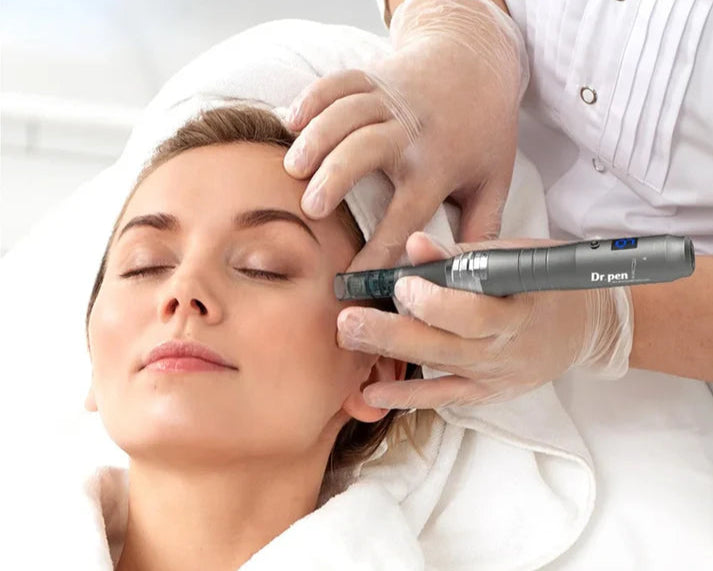Melasma, a common skin condition characterized by symmetrical, brownish patches on the face, particularly on the cheeks, nose, forehead, and chin, affects millions of people worldwide. This chronic skin pigmentation disorder is more prevalent in women, especially those with darker skin tones, and can be exacerbated by factors such as hormonal changes, sun exposure, and genetic predisposition. While melasma doesn't pose any health risks, it can significantly impact one's self-esteem and quality of life. As a result, individuals often seek effective treatment options to lighten these unsightly patches.

One such treatment that has garnered considerable attention in recent years is microneedling, particularly the use of a microneedling pen. But can this procedure truly help with melasma? To answer this question, it's essential to delve into the mechanics of microneedling, its potential benefits, and the scientific evidence supporting its use in managing melasma.
Microneedling, also known as collagen induction therapy, involves the use of a device equipped with fine needles that penetrate the skin's surface. In the case of a microneedling pen, these needles are arranged in a cartridge that can be adjusted to different depths, depending on the treatment area and desired outcome. When the pen is glided over the skin, it creates tiny punctures, triggering the body's natural healing response.
This healing process involves the production of new collagen and elastin fibers, which are crucial for maintaining skin structure and elasticity. Additionally, microneedling enhances the skin's absorption of topical products by creating microchannels that allow active ingredients to penetrate deeper into the dermis. This enhanced absorption can be particularly beneficial when combining microneedling with topical treatments specifically formulated for melasma, such as hydroquinone, kojic acid, or vitamin C.
Now, let's explore how microneedling might help with melasma. The primary mechanism by which microneedling could improve melasma is through its ability to stimulate skin cell turnover and promote the even distribution of melanin. Melanin is the pigment responsible for skin color, and its uneven distribution leads to the formation of melasma patches. By accelerating the skin's renewal process, microneedling may help fade these patches and achieve a more uniform skin tone.
Furthermore, microneedling can disrupt the melanin-producing cells (melanocytes) in the affected area, potentially reducing the amount of melanin produced. This disruption, combined with the enhanced absorption of topical treatments, creates a synergistic effect that may be more effective than using topicals alone.
Several studies have investigated the efficacy of microneedling in treating melasma. While the research is still in its early stages, the results so far are promising. One study published in the Journal of Dermatological Treatment found that microneedling combined with a topical depigmenting agent was more effective in reducing melasma than the topical agent alone. Another study, published in the Journal of Cosmetic Dermatology, reported significant improvement in melasma severity after a series of microneedling sessions.
Despite these positive findings, it's important to note that microneedling is not a one-size-fits-all solution for melasma. The effectiveness of the treatment can vary depending on several factors, including the individual's skin type, the severity of melasma, and the specific treatment protocol used. Moreover, microneedling carries some risks, such as infection, skin irritation, and hyperpigmentation, especially in individuals with darker skin tones. Therefore, it's crucial to consult with a qualified dermatologist or skincare professional before undergoing microneedling to ensure the procedure is safe and appropriate for your specific needs.
To maximize the benefits of microneedling for melasma, it's often combined with other treatments. For instance, dermatologists may recommend a series of microneedling sessions alongside a customized skincare regimen that includes topical depigmenting agents, sunscreen, and antioxidants. Sun protection is particularly important, as sun exposure is a major trigger for melasma. Using a broad-spectrum sunscreen with an SPF of 30 or higher and avoiding peak sun hours can help prevent melasma from worsening and protect the skin during and after microneedling treatments.
In addition to professional microneedling treatments, at-home derma rollers have become popular as a more affordable and accessible alternative. However, it's essential to exercise caution when using these devices. At-home derma rollers typically have shorter needles and may not penetrate the skin deeply enough to achieve the same results as professional microneedling. Moreover, improper use can lead to skin damage and complications. Therefore, it's advisable to consult with a skincare professional before attempting at-home microneedling and to follow their instructions carefully.
Another consideration when using microneedling for melasma is the potential for post-inflammatory hyperpigmentation (PIH). PIH can occur when the skin heals from inflammation or injury, leading to darkening of the affected area. This risk is higher in individuals with darker skin tones, who are already more prone to hyperpigmentation. To minimize the risk of PIH, dermatologists may recommend using topical treatments that inhibit melanin production, such as hydroquinone or kojic acid, before and after microneedling sessions.
Patient compliance and realistic expectations also play a crucial role in the success of microneedling for melasma. Melasma is a chronic condition that may require ongoing treatment to maintain improvement. Therefore, it's important to commit to a comprehensive treatment plan and understand that results may not be immediate or permanent. Regular follow-up appointments with a dermatologist can help monitor progress and adjust the treatment plan as needed.
In conclusion, microneedling, particularly with the use of a microneedling pen, shows promise as a treatment option for melasma. By stimulating skin cell turnover, enhancing the absorption of topical treatments, and potentially disrupting melanin production, microneedling may help fade melasma patches and achieve a more uniform skin tone. However, the effectiveness of the treatment can vary, and it carries some risks, especially for individuals with darker skin tones. Therefore, it's essential to consult with a qualified dermatologist or skincare professional, combine microneedling with other treatments as recommended, and maintain realistic expectations for the outcome. With careful consideration and a personalized approach, microneedling may be a valuable addition to your melasma management strategy.


Share:
Can Microneedling Pen Help with Keloid Scars?
How to Use a Microneedling Pen for Targeted Skin Concerns